Angkor's final chapter
Sat quietly in a clearing some 300 metres from the road that links the centre of Angkor Thom with its Victory Gate entrance, lies the final full stop in the last chapter of the great Angkor monuments. It's a temple with three names, known variously as Mangalartha, Monument 487 and Prasat Top East and it's rarely seen except by the nerdy temple enthusiasts. I found the entrance and cycled down the leafy path but it might be a bit trickier in the wet season if there are any streams about. If you visit this temple, you will be alone, surrounded by thick forest, birdcalls and shafts of sunlight filtering through the canopy - sounds idyllic doesn't it, so try it for yourself.
The monument itself is a single sandstone sanctuary, high on a narrow base, with four stairways but lacking a roof, lintels or pediments in situ. There is an inscribed doorjamb and a stele at the site revealed that it was built at the very end of the 13th century, after the death of Jayavarman VII and dedicated to one of his inner court. It is the last known monument to be constructed in the great Angkor period of temple-building. In the leaves that cover the ground you can see at least two broken pediments, showing Vishnu in various poses, and confirming that Mangalartha was dedicated to the god's memory. It is certainly not one of Angkor's most memorable monuments but a pleasant way to spend a few minutes in a place of solitude and quiet contemplation, and it was my first return to this temple since my first visit way back in 2000.
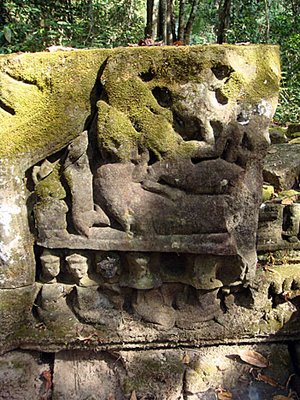 In the top register, you can see the upper half of Vishnu reclining on the serpent Ananta, whilst below are worshipping figures
In the top register, you can see the upper half of Vishnu reclining on the serpent Ananta, whilst below are worshipping figures
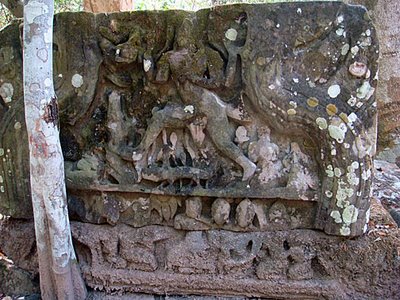 In this pediment, Vishnu is seen striding across the ocean with various figures and animals also shown but the sandstone hasn't fared well in the forest
In this pediment, Vishnu is seen striding across the ocean with various figures and animals also shown but the sandstone hasn't fared well in the forest
The monument itself is a single sandstone sanctuary, high on a narrow base, with four stairways but lacking a roof, lintels or pediments in situ. There is an inscribed doorjamb and a stele at the site revealed that it was built at the very end of the 13th century, after the death of Jayavarman VII and dedicated to one of his inner court. It is the last known monument to be constructed in the great Angkor period of temple-building. In the leaves that cover the ground you can see at least two broken pediments, showing Vishnu in various poses, and confirming that Mangalartha was dedicated to the god's memory. It is certainly not one of Angkor's most memorable monuments but a pleasant way to spend a few minutes in a place of solitude and quiet contemplation, and it was my first return to this temple since my first visit way back in 2000.
 In the top register, you can see the upper half of Vishnu reclining on the serpent Ananta, whilst below are worshipping figures
In the top register, you can see the upper half of Vishnu reclining on the serpent Ananta, whilst below are worshipping figures  In this pediment, Vishnu is seen striding across the ocean with various figures and animals also shown but the sandstone hasn't fared well in the forest
In this pediment, Vishnu is seen striding across the ocean with various figures and animals also shown but the sandstone hasn't fared well in the forestLabels: Angkor Thom, Mangalartha
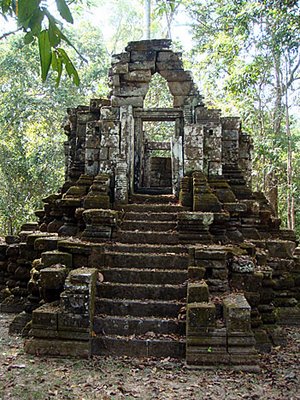
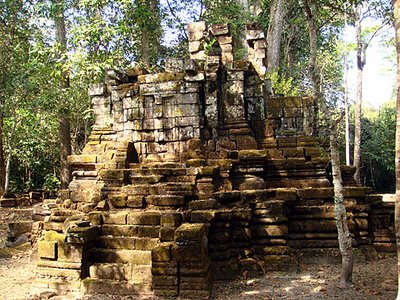
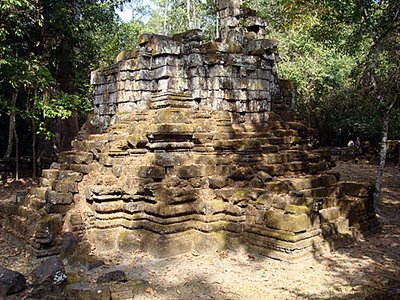
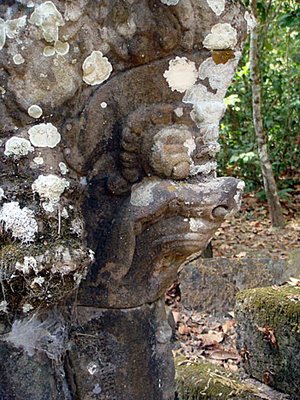


0 Comments:
Post a Comment
<< Home